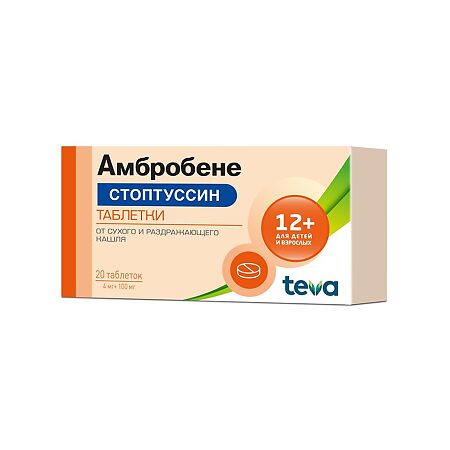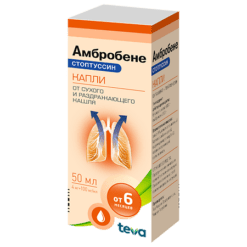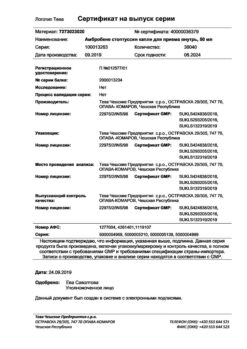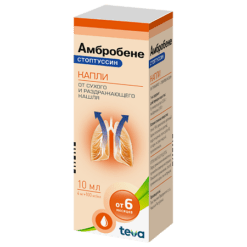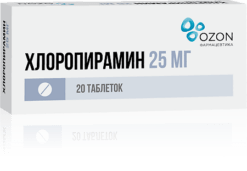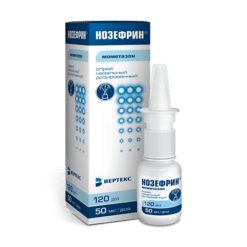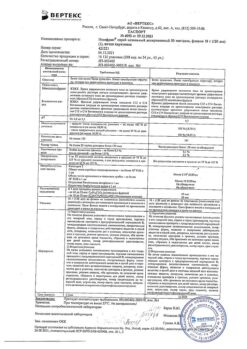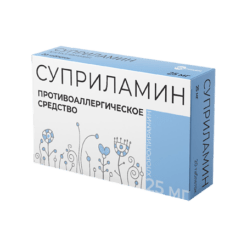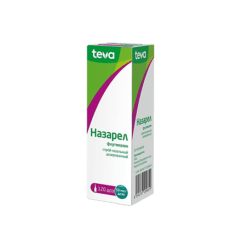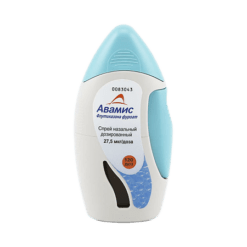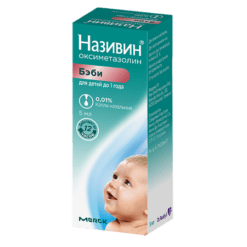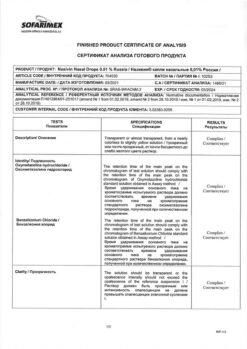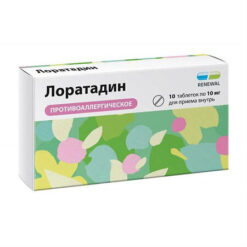No products in the cart.
Ambrobene Stoptussin, tablets 4 mg+100 mg 20 pcs
€7.97 €6.97
Description
Pharmacological properties
Pharmacodynamics.
A combined drug with anti-cough and expectorant effect. Butamirate has a peripheral local anesthetic effect on the sensitive nerve endings of the bronchial mucous membrane, which provides anti-coughing effect. Guaifenesin increases secretion of bronchial glands and reduces mucus viscosity.
The increase in secretion is caused both by direct action on the bronchial glands – stimulation of secretion from the bronchial glands and removal of acidic glycoproteins from acinar cells – and by reflexive way, when irritation of afferent parasympathetic fibers of the gastric mucosa and suppression of the respiratory center occur.
The increase in the tone of N. vagus stimulates the production of bronchial secretion. Mucus produced by bronchial glands increases activity of ciliated epithelium, as a result, evacuation of mucus from bronchi and coughing it up is facilitated.
Pharmacokinetics.
Butamirate is rapidly and completely absorbed when ingested. The binding to plasma proteins is 94%. It is metabolized to form 2 metabolites, also having antitussive effects. Metabolites are eliminated mainly (90%) by the kidneys and only a small part via the intestine. The elimination half-life (T1/2) is 6 hours.
Guifenesin when taken orally is rapidly absorbed from the gastrointestinal tract. Binding to plasma proteins is insignificant. Guaifenesin is rapidly metabolized to form inactive metabolites, which are excreted by the kidneys. T1/2 – 1 hour.
Indications
Indications
Dry and irritating cough of various etiologies (including infectious inflammatory diseases of the upper and lower respiratory tract).
Pharmacological effect
Pharmacological effect
Pharmacological properties
Pharmacodynamics.
A combined drug that has an antitussive and expectorant effect. Butamirate has a peripheral local anesthetic effect on the sensitive nerve endings of the bronchial mucosa, which provides an antitussive effect. Guaifenesin increases the secretion of bronchial glands and reduces the viscosity of mucus.
An increase in secretion is caused both by a direct effect on the bronchial glands – stimulation of secretion from the bronchial glands and removal of acidic glycoproteins from acinar cells, and by a reflex pathway, when irritation of afferent parasympathetic fibers of the gastric mucosa occurs and depression of the respiratory center.
Increased tone of N. vagus stimulates the production of bronchial secretions. The mucus produced by the bronchial glands increases the activity of the ciliated epithelium, as a result of which the evacuation of mucus from the bronchi and its coughing are facilitated.
Pharmacokinetics.
When taken orally, butamirate is quickly and completely absorbed. Plasma protein binding is 94%. It is metabolized to form 2 metabolites, which also have an antitussive effect. Metabolites are excreted mainly (90%) by the kidneys and only a small part through the intestines. Half-life (T1/2) – 6 hours.
Guaifenesin, when taken orally, is rapidly absorbed from the gastrointestinal tract. Communication with plasma proteins is insignificant. Guaifenesin is rapidly metabolized to form inactive metabolites that are excreted by the kidneys. T1/2 – 1 hour.
Special instructions
Special instructions
If symptoms persist, a change in treatment should be considered.
The drug should not be prescribed for productive cough in patients suffering from long-term or chronic cough (including those caused by smoking), bronchitis or emphysema.
Impact on the ability to drive a car or perform work that requires increased speed of physical and mental reactions.
The drug Stoptussin may have an adverse effect on the ability to drive vehicles and engage in other potentially hazardous activities that require increased concentration and speed of psychomotor reactions, due to the fact that it can cause dizziness and other side effects.
Active ingredient
Active ingredient
Butamirate, Guaifenesin
Composition
Composition
1 tablet contains active ingredients: butamirate citrate 4.0 mg, guaifenesin 100.0 mg; excipients: silicon dioxide 1.0 mg, mannitol 60.0 mg,
microcrystalline cellulose (PH 200) 60.0 mg, glyceryl behenate 1.0 mg, magnesium
stearate 4.0 mg.
Pregnancy
Pregnancy
The drug should not be used in the first trimester of pregnancy.
If it is necessary to use it in the second and third trimester of pregnancy, you should make sure that the expected benefit to the mother outweighs the potential risk to the fetus.
There is no reliable information about the penetration of butamirate and guaifenesin into breast milk.
It is necessary to stop breastfeeding while using the drug Stoptussin.
Contraindications
Contraindications
It should not be prescribed for myasthenia gravis, pregnancy (in exceptional cases, the drug can be prescribed only in the 2-3 trimesters), lactation, or hypersensitivity.
Side Effects
Side Effects
If the recommended dosage regimen is followed, patients usually tolerate the drug well. Nausea, vomiting, decreased appetite, stomach pain, dizziness, headache, drowsiness, hives and skin rash may occur. These effects
appear in approximately 1% of patients and usually resolve without dose reduction.
Adverse reactions are systematized in accordance with the World Health Organization (WHO) Classification: very common (≥1/10); often (≥1/100, <1/10); uncommon (≥1/1000, <1/100); rare (≥1/10000, <1/1000); very rare (< 1/10000); frequency unknown (cannot be determined from available data).
From the central nervous system: often – headache.
On the part of the organ of hearing and balance: often – dizziness.
From the digestive system: often – nausea, anorexia, abdominal pain, vomiting,
diarrhea; very rarely – bitter taste in the mouth, heartburn, feeling of heaviness in the epigastrium.
From the respiratory system: very rarely – shortness of breath.
From the cardiovascular system: rarely – chest pain; very rarely – tachycardia, palpitations.
From the skin and subcutaneous fat: very rarely – itching, exanthema,
urticaria, hot flashes.
Other: very rarely – pain around the eyes.
Interaction
Interaction
Guaifenesin enhances the analgesic effect of paracetamol and acetylsalicylic acid, the effect of alcohol, sedatives, hypnotics and general anesthetics on the central nervous system, and the effect of muscle relaxants.
When determining the concentration of vanillylmandelic acid and 5-hydroxyindoleacetic acid using nitrosonaphthol as a reagent, false positive results may be obtained.
Therefore, treatment with guaifenesin should be discontinued 48 hours before urine collection for this test.
Overdose
Overdose
Symptoms: in case of overdose, signs of the toxic effects of guaifenesin predominate – drowsiness, muscle weakness, nausea, vomiting, urolithiasis.
Treatment: in case of overdose, consult a doctor. Guaifenesin does not have a specific antidote. Gastric lavage, activated charcoal, and symptomatic therapy (support of cardiovascular, respiratory and renal functions, electrolyte balance) are prescribed.
Storage conditions
Storage conditions
Store at a temperature not exceeding 25 °C.
Keep out of the reach of children!
Shelf life
Shelf life
5 years.
Do not use after expiration date.
Manufacturer
Manufacturer
Teva Operations Poland Sp. z o.o., Poland
Additional information
| Shelf life | 5 years. Do not use after the expiration date. |
|---|---|
| Conditions of storage | Store at a temperature not exceeding 25 °C. Keep out of reach of children! |
| Manufacturer | Teva Operations Poland Sp. z o.o., Poland |
| Medication form | pills |
| Brand | Teva Operations Poland Sp. z o.o. |
Other forms…
Related products
Buy Ambrobene Stoptussin, tablets 4 mg+100 mg 20 pcs with delivery to USA, UK, Europe and over 120 other countries.

